HESP 403 Final Exam
1/143
There's no tags or description
Looks like no tags are added yet.
Name | Mastery | Learn | Test | Matching | Spaced |
|---|
No study sessions yet.
144 Terms
what are sonorant consonants?
nasals /m/, /n/, /ŋ/
lateral /l/
retroflex /ɹ/
glides /w/, /j/
what sonorant consonants are considered nasals?
nasals /m/, /n/, /ŋ/
what is the main characteristic of sonorant consonants in term of constriction?
sonorant consonants are produced with little constriction
are sonorant consonants voiced or voiceless?
always voiced
what type of sound source is involved in producing sonorant consonants?
a glottal sound source
how are sonorant consonants similar to vowels in acoustic structure?
they are relatively intense and long and contain formants
what is the acoustic model used for sonorant consonants?
sonorant consonants are modeled by shunt resonators
how do shunt resonators for sonorant consonants differ from single-tube resonators?
shunt resonators behave differently by modeling sound sources between two resonators but the sound source in sonorants is glottal
which sonorant consonants are glides?
glides /w/, /j/
which sonorant consonant is classified as a lateral?
/l/
which sonorant consonant is classified as a retroflex?
/ɹ/
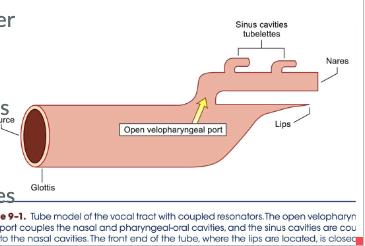
What happens to the velopharyngeal port during nasal consonant production?
The velopharyngeal port is open (velum is lowered)
where does resonance occur for nasal consonants?
resonance occurs throughout the entire vocal tract, including nasal cavity
which resonators are together in the production of nasal sounds?
the oral-pharyngeal cavity and the nasal cavity
what are the “side branches” or shunts in nasal consonants?
the oral cavity and sinus cavity tubelettes, which are closed during nasal resonance
what acoustic effect is created by the shunt resonators in nasal consonants?
shunts resonate but act as acoustic dead ends creating antiresonances
what is an antiresonance in nasal consonants?
a phenomenon where energy is “trapped” in shunts, reducing the amplitude of certain frequencies
why does antiresonance occur in nasal consonants?
because energy is trapped in the closed side branches or shunts
how does the length of the tube from the glottis to the nares affect resonant frequencies in nasal consonants?
A long tube from the glottis to nares create lower resonant frequencies
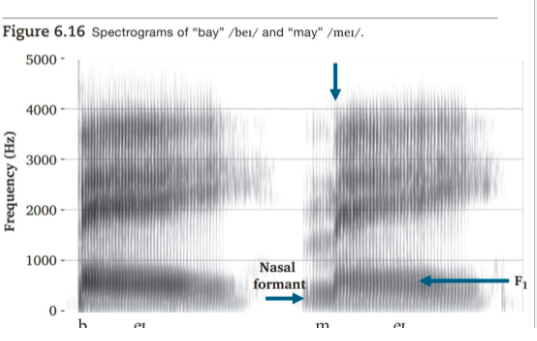
what is the frequency range for the nasal formant in nasal sounds?
around 250-300 Hz
what occurs in the formants when a nasal sound is produced?
there is an abrupt shift in formants
what acoustic feature is characteristic of nasal sounds and results from trapped energy?
antiresonance
what is a nasalized diphthong?
a diphthong sounds that included nasal resonance
which formant is most affected by antiresonance in nasal sounds?
Affects the fifth formant (F5)
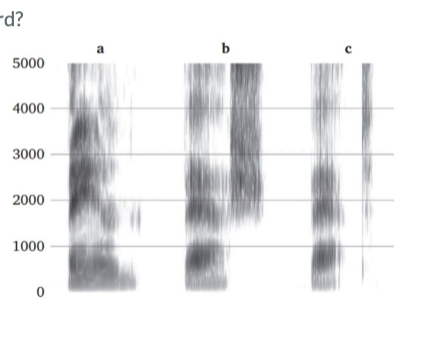
which spectrogram goes with the word "Bat”
spectrogram B
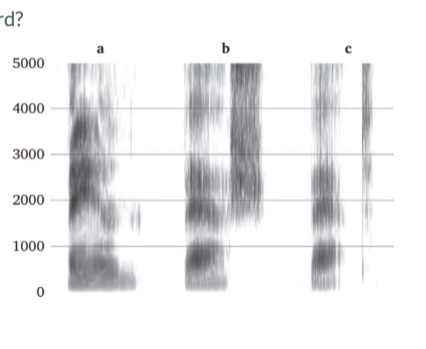
which spectrogram goes with the word “Ban”
spectrogram A
Which spectrogram goes with the word “Bash”
spectrogram C
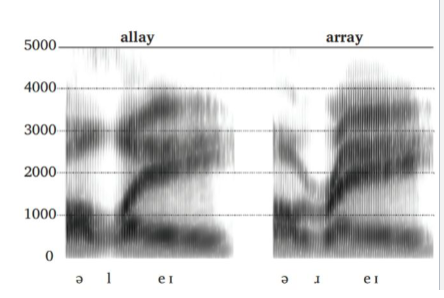
what is a characteristic feature of the /ɹ/ sound in terms of formant structure?
/ɹ/ has a low F3, which brings F2 and F3 close together
“array”
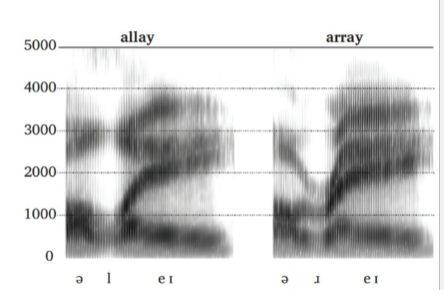
what acoustic feature is associated with the /l/ sound?
/l/ has antiresonance which results in energy reduction at certain frequencies
“allay”
whats the difference in F3 transition in /ɹ/ and /l/?
/ɹ/ has a low F3 at onset which rises, /l/ has a higher F3 that does not start low like /ɹ/
how are formants of glides similar to vowel diphthongs?
the structure is similar but they are shorter and weaker (less intense)
what is the characteristic formant pattern of /w/?
/w/ has low F2 and low energy in high formants
What is the formant pattern of /j/ and why?
/j/ has a high F2 and more energy in high formants, due to palatal place of articulation
what is aspiration in voiceless stops?
aspiration occurs during the production of a voiceless stop, when turbulent airflow is created as the vocal folds adduct to initiate voicing for the following sound
how is aspiration represented in phonetic notation?
represented by a superscript lowercase “h” after the phonetic symbol
give an example of an aspirated voiceless stop
[pʰ], [tʰ], and [kʰ]
what cues indicate a voiceless stop in English?
Cued by long VOTs and aspiration between the burst and the onset of voicing
How does aspiration appear acoustically on a spectrogram?
appears as white noise, which is an aperiodic continuous noise with energy at all frequencies
what does it mean when a sound is voiceless or devoiced?
when a sound that is typically produced with voicing is produced partially voiceless (or without full voicing) (voicing ends early or starts late)
how is devoicing represented in phonetic notation?
a small open circle underneath the phonetic symbol
example of devoiced sound
[d̥], [z̥], [l̥]
how can vowel duration help determine if a sound is voiceless or devoiced?
if a vowel before the sound is long, it is devoiced
if a vowel before the sound is short, it is voiceless
what does it mean for a consonant to be syllabic?
a syllabic consonant functions as the nucleus of a syllable
which types of consonants can be syllabic?
unstressed nasals and liquids such as [n], [m], [l], and [ɹ]
how is a syllabic consonant represented in phonetic notation?
represented with a small vertical line underneath the phonetic symbol
[n̩], [m̩], [l̩], and [ɹ̩]
What does CCVC’CVC represent in phonetic stress notation?
a word with primary stress on the syllable marked by the apostrophe, following a consonant-consonant-vowel-consonant (CCVC) and consonant-vowel-consonant (CVC) structure
what is rhoticity?
the quality of sounds that include an "r” coloring particularly in sounds like [ɚ] where the "r” sound is pronounced
what does nasalization mean in phonetics and how is it notated?
Means that air flows through the nose during production of a sound .
It's represented with a tilde above the vowel symbol: [æ̃]
how is vowel length indicated in phonetics?
Vowel length is indicated with a colon symbol after the vowel, such as [æː]
what does an “unreleased” stop mean
a stop consonant where there is no audible burst of air release at the end, meaning the sound is “held” rather than fully released
How is an unreleased stop represented in phonetic transcription?
An unreleased stop is indicated by a small diacritic mark (') after the consonant such as [p̚]
what is velarization?
a secondary articulation where the back of the tongue is raised toward the velum
how is a velarized or dark /l/ represented in phonetic transcription
by the symbol [ɫ]
when does dark /l/ occur in English
Dark /l/ occurs in syllable-final positions such as the word “full”
what does voicing on a continuum mean?
voicing varies in degree and can range from fully voiced to voiceless
How is a creaky or partially voiced sound represented in phonetic transcription?
diacritic below the vowel [ḭ]
how is a breathy voice sound represented in phonetic transcription?
indicated with a diacritic below the vowel [i̤]
what does palatalized mean?
it refers to a sound produced with an off-glide towards the palate
How is palatalization represented in phonetic transcription?
adding a superscript "j” to the phonetic symbol
what symbol indicates a palatalized sound such as cube?
[kʲ] indicates a palatalized sound
what does labialized mean?
a sound produced with rounded lips
how is labialization represented in phonetic transcription?
Shown by adding a superscript "w” to the symbol such as [tʷ] or [sʷ].
what does dental articulation refer to
it refers to a sound produced with the tongue against the upper teeth, like “eighth” or “birthday”
How is a dental sound indicated in transcription?
marked with a small diacritic underneath the symbol [t̪]
negative VOT
voicing begins the stop is released
short VOT
voicing begins almost immediately after the stop is released
intermediate VOT
voicing begins shortly after the stop is released
Long VOT
voicing begins long after the stop is released
when are stops unreleased
when they occur before another stop
when are voiceless stops aspirated?
voiceless stops are aspirated when they are word-initial or syllable-initial
when are voiced obstruents devoiced
at the end of an utterance or before a voiceless sound
what happens to voiced stops and fricatives when they are syllable-initial or preceded by a voiceless sound?
they become voiceless
when is the aspiration rule for voiceless stops after /s/?
voiceless stops are unaspirated when they come after /s/
how do voiceless obstruents differ from voiced ones in syllable-final position?
voiceless obstruents are longer than the corresponding voiced ones in syllable-final position
how is /t/ modified when it occurs before an alveolar nasal in the same word?
Replaced by a glottal stop when it occurs before an alveolar nasal in the same word
what often accompanies syllable-final voiceless stops
an overlapping glottal stop
what happens to approximants when they are preceded by voiceless stops?
approximants are partially voiceless
when do nasals become syllabic?
Nasals become syllabic at the end of a word when immediately following an obstruent
when do liquids become syllabic?
at the end of a word when immediately following a consonant
when do liquids become syllabic?
at the end of a word when immediately following a consonant
what happens to alveolar stops (including nasal) in intervocalic position, especially when the second vowel is unstressed?
voiced alveolar taps in intervocalic position
when do alveolar consonants become dentals?
before interdental consonants
what happens to alveolar stops when they are between consonants
alveolar stops are reduced or omitted when between consonants
when might a homorganic voiceless stop occur after a nasal?
before a voiceless fricative followed by an unstressed vowel in the same word (epenthisis; “prince” or “something”
how are consonants affected when they are before an identical consonant?
a consonant is shortened when it is before an identical consonant (good day)
how do velar stops change before front vowels?
velar stops become more fronted before front vowels
when does /l/ become velarized?
it occurs after a vowel or before a consonant at the end of a word
in terms of vowel length, how does a vowel's placement in a syllable affect its duration
a vowel is longest in an open syllable
next longest in a syllable closed by a voiced consonant
shortest in a syllable closed by a voiceless consonant
how does stress affect vowel length?
vowels are longer in stressed syllables
when might a reduced vowel become voiceless?
when it occurs after a voiceless stop and before another voiceless stop
when are vowels nasalized?
syllables closed by a nasal consonant
what happens to vowels in syllables closed by /l/?
add a high back lax vowel before velarized /l/ (in “peel”)
syllable structure constraints
rules that determine the allowable arrangements of phonemes within a syllable, such as the possible pattern (CCCVCCCC)
positional constraints in phonotactics?
rules that restrict certain phonemes to specific positions within a word
sequential constraints in phonotactics
rules that determine the allowable order of phonemes within a word
what is coarticulation?
how each sound in speech is influenced by the surrounding sounds
/mæn/ is produced [mæ̃n]
carryover coarticulation
a sound is affected by the preceding sound, as speech unfolds in time (A → B)
Anticipatory coarticulation
A sound is affected by the following sound, changes in anticipation of the next sound (A ← B)
/h/
/ki/ vs /ku/: place of articulation, lip rounding
aspiration
extra noisy (fricational) burst associated with voiceless stops /p/, /t/, /k/ in initial position
stop gap occurs when…
airflow is fully obstructed